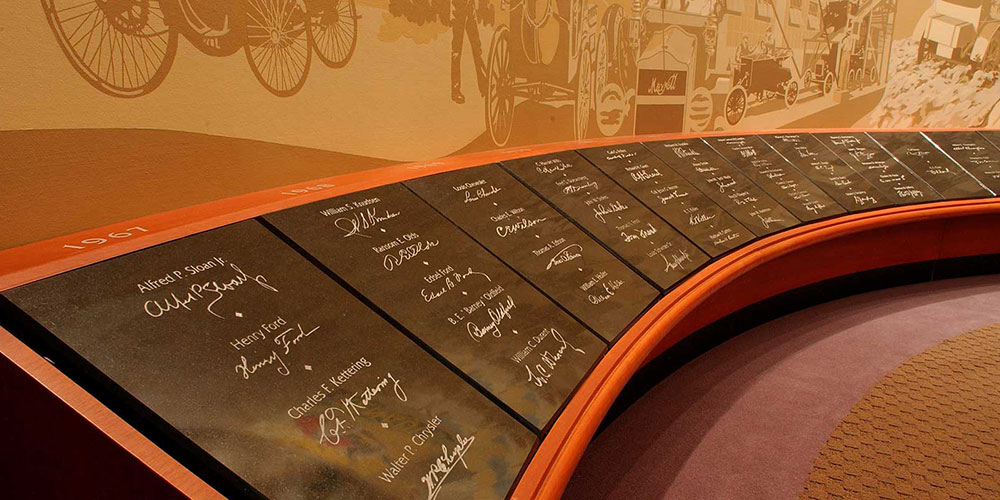By Robert Tate, Automotive Historian and Researcher
Photos courtesy of General Motors Archives and the National Automotive History Collection
Posted: 11.30.2015
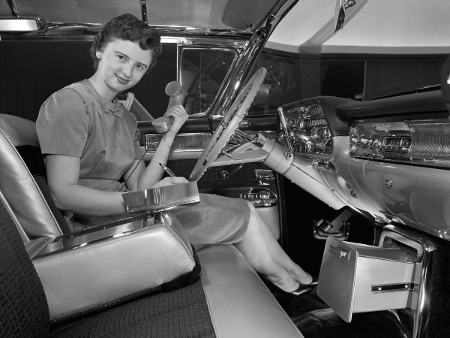 Sue Vanderbilt in a 1958 Cadillac Eldorado Seville “Baroness;" the show car that she styled for the Feminine Show.When you look back at General Motors’ rich design history, one of the most talented individuals, who made her career as part of GM’s vaunted Creative Design Team, was the late Suzanne E. Vanderbilt.
Sue Vanderbilt in a 1958 Cadillac Eldorado Seville “Baroness;" the show car that she styled for the Feminine Show.When you look back at General Motors’ rich design history, one of the most talented individuals, who made her career as part of GM’s vaunted Creative Design Team, was the late Suzanne E. Vanderbilt.
Vanderbilt was one of the original Damsels of Design – a group of eight, great talented female designers that the famed Harley Earl hired during the early days of the 1950s.
From basic pencils sketches to designing stylish looking interiors for General Motors products, Vanderbilt remains a giant in our great automotive design heritage.
This story will focus on the great accomplishments Vanderbilt had contributed to the history of design and within the auto industry during the 1950s to 1970s.
Vanderbilt was born in Mount Vernon, New York but grew up in nearby Larchmont just six miles northeast.
As a child, Vanderbilt always showed a strong interest in the study of anything mechanical but found that breaking into those traditional male-dominated industries was easier said than done.
“I needed to know how things worked,” Vanderbilt once said. “With so many doors closed to women, I retreated to music – a proper ambition. It gave me a great background, and I use that now, but then I was heartbroken.”
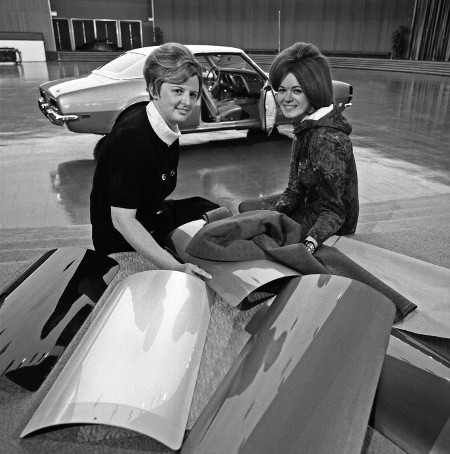 Suzanne Vanderbilt (Left) and Cathy Kacsur Wagner (later Denek) (Right).
Suzanne Vanderbilt (Left) and Cathy Kacsur Wagner (later Denek) (Right).
Later, Vanderbilt graduated from Pratt Institute in Brooklyn, New York, where she earned a Bachelor’s of Industrial Design. At the Pratt Institute, Vanderbilt had learned early on about the techniques of basic design along with dimensional design and empathic sketching.
Speaking to maintaining the balance between design and functionality, Vanderbilt once said that she thought of herself as more of an artist.
“I have the feeling that I'm more artist than designer perhaps one expression overlaps another,” she said.
Two individuals who played a significant role in Vanderbilt's industrial design career from the beginning were Rowena and Alexander Kostellow, who was the head of the Industrial Design Department at Pratt Institute. It was the late Rowena, an instructor at Pratt, who urged Vanderbilt to pursue her aspirations as an automotive designer and apply to the General Motors Styling Department.
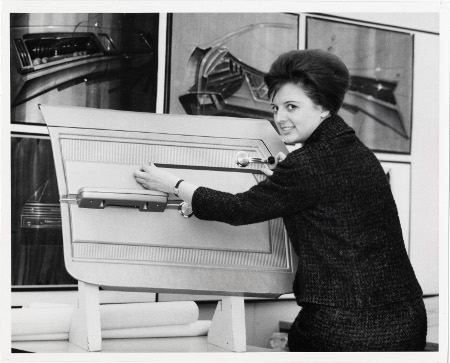 Sue Vanderbilt GM designer staff in the late 1960sAfter her portfolio review and many great sketches rendered, General Motors made her an initial offer in July, 1955. About the same time when Vanderbilt was hired in, two other talented young female designers were also starting their careers with the GM Styling Dept. – Jeanette Linder and Ruth Glennie. Those three and Peggy Sauer, Marjory Ford Pohlman, Sandra Longyear, Dagmar Arnold, Jane Van Alstyne, Gere Kavanaugh made up Harley Earl’s famed Damsels of Design.
Sue Vanderbilt GM designer staff in the late 1960sAfter her portfolio review and many great sketches rendered, General Motors made her an initial offer in July, 1955. About the same time when Vanderbilt was hired in, two other talented young female designers were also starting their careers with the GM Styling Dept. – Jeanette Linder and Ruth Glennie. Those three and Peggy Sauer, Marjory Ford Pohlman, Sandra Longyear, Dagmar Arnold, Jane Van Alstyne, Gere Kavanaugh made up Harley Earl’s famed Damsels of Design.
Vanderbilt at GM, 1955-1977
Vanderbilt's first design assignment started within the Chevrolet design studio team, where she became involved in many great and creative projects for instrument panel designs.
As her career would continue with General Motors, Vanderbilt moved from Chevrolet interiors to Cadillac which provided a wonderful and exciting experience. Vanderbilt also became involved in General Motors’ advanced studio, where she had a very small part in designing a small interior part for the Firebird III concept car which was a hit at a number of auto shows that year.
Speaking to working alongside her make counterparts, Vanderbilt said the learning was steep within the GM design studio.
“I’ll tell you, you learn very, very fast and it wasn’t more than a few months, and we could do just as well as some of the men, I must say,” Vanderbilt said.
In 1958, Harley Earl, introduced the Spring Fashion Festival of Women Designed Cars. This show was held at the GM Technical Center Design Dome and was the first design show that women could actually display and share their great ideas of styling with the public.
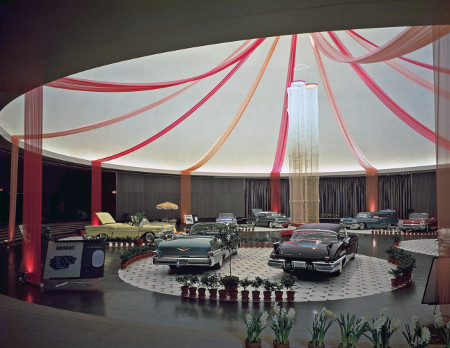 The "feminine show" was a showcase for the work of the "Damsels of Design," a group of women designers in the 1950s.The show was a huge success and many new styling ideas were discovered. Earl at the time credited the unique color arrangements to his Damsels of Design team as reported in the Detroit Free Press, “Harley Earl, vice president in charge of styling, credits these designers with many of the unusual color combinations. When Earl gave his women designers the green-light on choosing special colors and interiors for 10 hardtops and convertibles the results were highly original.”
The "feminine show" was a showcase for the work of the "Damsels of Design," a group of women designers in the 1950s.The show was a huge success and many new styling ideas were discovered. Earl at the time credited the unique color arrangements to his Damsels of Design team as reported in the Detroit Free Press, “Harley Earl, vice president in charge of styling, credits these designers with many of the unusual color combinations. When Earl gave his women designers the green-light on choosing special colors and interiors for 10 hardtops and convertibles the results were highly original.”
Vanderbilt had designed two special Cadillacs – an Eldorado Seville coupe called the Baroness which was available with a telephone and much added compartment space for the driver and passengers. Vanderbilt’s other model was the Cadillac Saxony convertible, which was offered in a beautiful gray-green metallic color.
During the 1960s through the 1970s, Vanderbilt continued worked on many assignments and contributed a great deal to the iconic GM auto design. Later in her career, she became assistant chief designer for Chevrolet I and II studios, where she had demonstrated many great leadership skills within the design studio, and also completed her master’s degree.
In conclusion, Vanderbilt designed so many great products for example, interiors for the Chevrolet Vega and Monza models along with Cadillac and many other exciting projects as well. In 1973, Ms. Vanderbilt began to have problems with her health and on June of 1977, she retired unfortunately. Today, Ms. Vanderbilt is no longer with us however her kind spirit and great dedication will always be a part of our automotive design heritage.
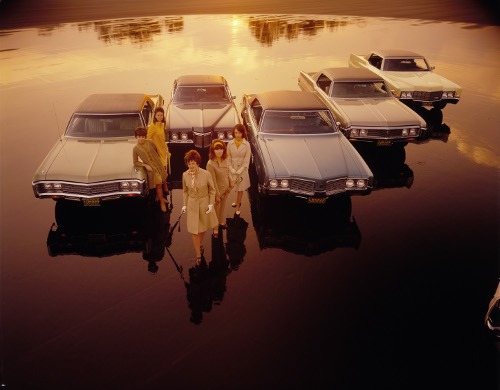 The last image(1969) show here highlights Vanderbilt along with many other talented female designers that included were from clockwise from the top were Cathy S. Denek, Joan Gatewood, Sue Vanderbilt, Margaret Schroeder and Bernadette Mar. A special thank you to the General Motors Heritage Center staff - Christo Datini, Lead Archivist; John Kyros and Natalie Morath - for help in the production of this article.
The last image(1969) show here highlights Vanderbilt along with many other talented female designers that included were from clockwise from the top were Cathy S. Denek, Joan Gatewood, Sue Vanderbilt, Margaret Schroeder and Bernadette Mar. A special thank you to the General Motors Heritage Center staff - Christo Datini, Lead Archivist; John Kyros and Natalie Morath - for help in the production of this article.
A special thanks to Robert Tate, Automotive Historian and Researcher, for contributing the story to the MotorCities Story of the Week program. Photos courtesy of General Motors Archives and the National Automotive History Collection. (Bibliography: Crippen David, Automotive Design Oral History Project, “The Reminiscences of Suzanne E. Vanderbilt,” 1985; Ash, Agnes. “Designing women go crazy with cars," Detroit Free Press, June 3, 1957; Stork, Jeff. “Damsels of Design: Harley Earl's Designing women” September 21, 2015. )
For further information on photos please visit http://www.detroitpubliclibrary.org/ or email This email address is being protected from spambots. You need JavaScript enabled to view it.. Please do not republish the story and/or photographs without permission of MotorCities National Heritage Area.
If you would like to contribute an article for the MotorCities newsletter, email This email address is being protected from spambots. You need JavaScript enabled to view it. or call 313-259-3425.


